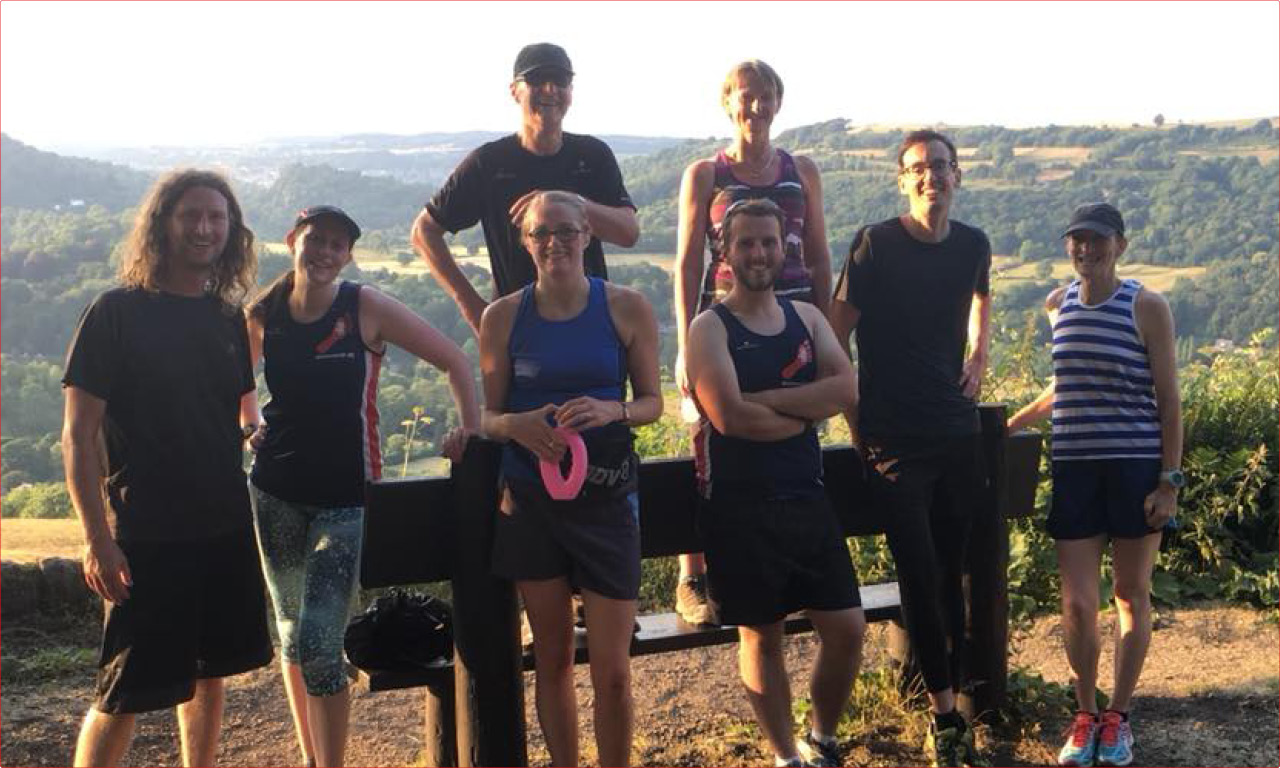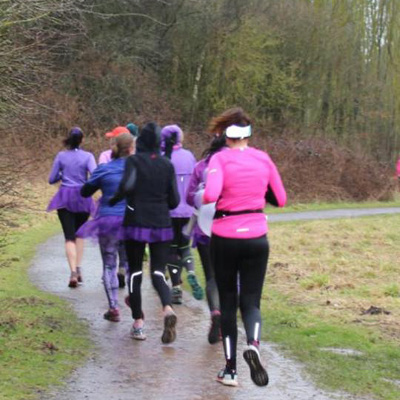My name is Rachel, I have an ileostomy. During my recovery, I have learned to run. Before my operation, I’d never been a jogger or a runner, although I did go to the gym. It was only when I was recovering from a second abdominal operation for Crohn’s disease that I took it up.
First steps
At first, I was advised to take things slowly, and this meant changing up my old routine. For the moment, it was out with my intense workouts and in with gentler activities—aerobics, swimming and walking/jogging were said to be best to start with.
Preferring to keep my feet on dry land, I began walking around the area where I live. I soon found myself picking up speed; I started jogging, and, before I knew it, I was running.
‘I soon found myself picking up speed’
I was really feeling my stride, managing to run a couple of kilometres a few times a week. I looked for somewhere to step up my game, and found parkrun, who organise free 5km runs in parks every Saturday. They are open to everyone, free and safe and easy to take part in; find your local parkrun at www.parkrun.org.uk.
Hitting the trail
Compared with pounding the pavement around my home, parkrun’s cross-country courses were really putting a spring in my step. The softer ground made for a less intensive run, ideal for someone recovering from surgery or who wants to avoid a parastomal hernia (or, in my case, a reoccurrence of one). I soon wanted to get even further off road, so I started to tag along with trail running groups.
I found traversing the rugged, changing terrain of fields and woodlands makes for a much more interesting run, as, with every step, you have to think technically about the route your feet are about to take. There’s a definite sense of achievement too when you feel you’ve conquered some tricky terrain without rolling over on your ankle.
‘I felt free, like a kid again’
Not only is a trail physically more fun to run, there’s also the feeling of getting out into the countryside and enjoying fantastic views, even catching glimpses of wildlife. As the seasons change, so do the trails, so even running the same track never gets old. There was no stopping and waiting to cross a busy road. Charging down a hillside, I felt free, like a kid again.
Key kit for running with a stoma
• Stoma support belt When exercising, this is essential to prevent a parastomal hernia occurring or to support an existing one
• Extender strips With extra strain on your pouch, you may want to use these to build up the flange and ensure the seal stays strong and tight
• Fluid backpack You will need lots to drink, especially in hot weather or with a high‑output stoma
• Radar key This will get you access to disabled loos across the UK
• Emergency changing kit In case your pouch fills up or even leaks, you’ll need to be able to change it (I take loo roll, wet wipes, hand sanitiser, barrier wipes, adhesive remover wipes, stoma paste and a pre-cut pouch or two, all of which fit in a small gadget case in my fluid backpack)
• Disposal bag Should you get caught out on the trail without a loo when your stoma needs a change, you’ll need something to empty it into and carry to the next bin
• Medical ID wristband In case of an accident, this lets people know you have a stoma, as well as anything else they should know (I improvised one from a parkrun band)
Running with a stoma
 Any fears I had that my stoma might hold me back were unfounded, and it’s something ostomates can excel at. For the most part, it’s a level playing field, and you can run any distance you set your mind to, but you do need to adapt and do things a little different to others.
Any fears I had that my stoma might hold me back were unfounded, and it’s something ostomates can excel at. For the most part, it’s a level playing field, and you can run any distance you set your mind to, but you do need to adapt and do things a little different to others.
Whether you’ve had a hernia or not, you need to keep your abdomen supported. I’ve found the support belt holds up my stoma nicely and hasn’t had a negative impact on my running technique.
I always use extender strips to give my pouch some extra security, and, so far so good, I’ve had no leaks to speak of. Although, I do take a spare pair of pants just in case. Ileostomates taking up trail running should be prepared to get closer to nature for some mid-run emergency emptying, but a two-piece pouch means you won’t have to remove the entire appliance. Without access to warm water or adhesive remover spray, a full pouch change is more challenging and could leave the skin a little uncomfortable.
Nobody will know you have a stoma unless you tell them; I don’t look any different to anyone else in my running gear with a thick support band underneath it. There’s no need to feel self-conscious or worry about people looking at your abdomen. The only thing that gives me away is my fluid backpack.
Well-watered
Because ileostomates have decreased fluid absorption, we need to drink much more than other runners. Many people without a stoma run with nothing more than a key in their pocket, and I know those who do half-marathons without a bottle of water and rely instead on feed stations. Even on shorter runs (5km), as well as drinking what I can from feed stations, I carry a fluid backpack. This is also remarkably useful for carrying a stoma changing kit.
‘we need to drink much more than other runners’
I up the amount I drink in hot weather. I also wear a running cap, which cools you down by drawing away perspiration and keeping the sun from your face. I also carry a little spray bottle to keep my face refreshed and try to do non-event runs in the morning or evening, when its cooler. When it’s hot, even when you don’t feel thirsty, you will need a lot to drink. To cope with the heat, I’ve remembered to keep gradually sipping fluids, even if I don’t feel like I need them, so I am constantly staying hydrated. Staying hydrated can be easier if you use hydration tablets and mix up a range of fluids, not just water, and I take a pack of Dioralyte in my kit.
How much fluid I drink on a run
|
Distance |
Cool weather |
Hot weather |
|
5km |
500ml |
1000ml |
|
10km |
1000ml |
1500ml |
|
20km |
1500ml |
2000ml |
Fed up
It helps to time eating around when I want to empty my stoma bag. For a long run (10km and up), I won’t eat a huge amount the night before, and I’ll eat something that I know will produce a manageable output: chicken, vegetables and potatoes are ideal for me. In the morning, I try and eat fairly early so my output isn’t too watery; typically I’ll have something like porridge or Weetabix and a banana.
On the run, I like to eat jelly babies, protein bars and bananas, as well as sports hydration tablets. I have avoided trying sports gels, in case my already rather productive ileostomy’s output gets too watery. Besides, I love eating and don’t fancy switching to liquid space food yet.
‘managing my output hasn’t ever really affected my running’
Before I’m due to set off, I’ll empty my bag at the last minute, making sure to get all the air out of it. Beyond these preparations, managing my output hasn’t ever really affected my running. I can generally run at any time of the day, even if it’s later in the evening after a day of eating.

On the trail with Rachel’s run club (second from left)
The path ahead
After running some half marathons, I have more planned, and I’m now aiming at 30km. For me, the famous city marathons don’t appeal to me half so much as off-road events.
I’d love to take part in some cross-country ultra-running events, where I could camp and continue the next day. There’s the Race to the King ultra-marathon, over the South Downs for over 50km to Winchester Cathedral. Then there’s the Race to the Stones, which runs for 100km over the Chilterns and the North Wessex Downs, passing castles and ancient monuments, with names like Grim’s Ditch, Wayland’s Smithy and the Uffington White Horse, and ending at Avebury Stone Circle. That’s the ultimate goal, but like anyone with their hobbies, it’s finding the time!

Jogging with parkrun
 Rachel Carey has had an ileostomy since 2015; she blogs about living a healthy, active and positive life with a stoma
Rachel Carey has had an ileostomy since 2015; she blogs about living a healthy, active and positive life with a stoma
Blogspot
The contents of this page are property of MA Healthcare and should not be reused without permission

